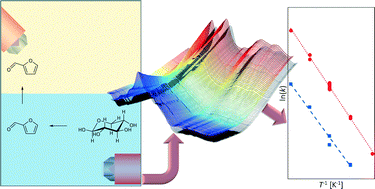Process analytical technology (PAT) applied to biomass valorisation: a kinetic study on the multiphase dehydration of xylose to furfural†
Abstract
We present a methodology for evaluating the kinetic parameters of biomass transformations employing process analytical technology (PAT). The salient feature of this strategy involves the determination of reaction rates and activation energies for biomass conversions under process conditions without influence from possible side reactions or fouling of optical probes. PAT was applied to the dehydration of the C5-sugar xylose to the platform chemical furfural as a model reaction system. The reaction was monitored in situ in a biphasic 2-methyltetrahydrofuran/water (2-MTHF/H2O) system by ATR mid-IR and Raman spectroscopy at different reaction temperatures. We evaluated the reaction kinetics for the dehydration of xylose to furfural and the side reaction of humin formation by chemometric and kinetic modelling of the inline data. The activation energy for xylose dehydration (151 ± 3 kJ mol−1) was slightly higher than that for humin formation (139 ± 7 kJ mol−1). This insight allowed for the proposal of an optimised reactor concept to maximise the yields of furfural and minimise the production of humins.


 Please wait while we load your content...
Please wait while we load your content...